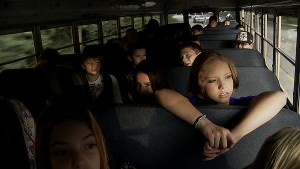
After a good bit of hemming and hawing over its original R rating, the eventual unrated release, and now—presumably because most theater chains won’t touch an unrated picture—a PG-13 edition hitting theaters, the much talked about Bully has landed locally. With all of the publicity swirling around the film’s rating controversy—the idea being that the 17-and-under set are the exact ones who need to see Bully—this is not a film for kids, and it never was intended to be. Instead, it’s a film for parents that addresses the institutional failure that allows bullying to breed, something that makes the whole rating hullabaloo feel like the promotional stunt it most likely was.

But specious marketing plans should not be a reason to sell Bully short. What director Lee Hirsch has made is an incredibly emotionally arresting documentary that shows the effects and outcomes of teenage bullying, including the most extreme cases that end in suicide. And while it doesn’t seem like it at first, this is very much an activist documentary, as much as you’d get from Michael Moore or any other documentarian with a camera and an agenda. This doesn’t mean you should discount Bully (again, most documentaries reflect the biases of their makers—there is no such thing as “objective” here), but you should definitely take some of its aspects with a grain of salt.

A good example is one of the film’s central stories, which revolves around the suicide of 17-year-old Tyler Long. Slate has already tackled this aspect of the film, mentioning how Bully only examines Tyler’s parents’ fight against the school board, who they blame for ignoring the bullying that Tyler suffered. The film, however, ignores Tyler’s history of mental illness and depression because it doesn’t jibe with the film’s concerns, something that unfortunately will always be an inherent problem in documentary filmmaking. Werner Herzog’s Into the Abyss was criticized for similar reasons last year, as subjectivity can never be removed from art—and probably shouldn’t be minimized.

Regardless, Tyler’s story—or at least the aspects we learn about it—fit into a larger tapestry. Within the context of the film—and only the film—we’re shown public school systems that are rampant with teasing and physical violence. Bully is a film devoid of statistical analysis, so we’re left to witness the bullying first hand, through the eyes of a socially awkward young teen in Iowa, a lesbian girl living in rural Oklahoma, and others. That lack of cold, hard facts leaves the viewer to trust Hirsch, who doesn’t delve into minutiae because he’s looking for an emotional response, as we get to know these kids who exist in schools that can’t protect them, and parents who don’t always know how to deal with these situations. And on screen, at least, the world that Bully presents—a world run by adults who aren’t quite suited to protect these children—is often heartbreaking. Yes, the film Hirsch has made is awfully manipulative, but the sorrow he presents is ultimately the point of Bully, and is admittedly effective. Rated PG-13 for intense thematic material, disturbing content, and some strong language—all involving kids.




It’s worth noting that this tanked big time and will be gone come Friday.
I’m interested. And I’d go see it, but… I’ve got a 29-year strong streak going of waiting for docs to show up at the video store. Sure I’m forever living slightly behind the times but it’d be a shame to ruin it now.
As much as I advocate seeing movies in theaters, I have trouble arguing with this practice — only because so few documentaries really benefit from size. Now, they benefit from being seen in a dark, theoretically distraction-free auditorium.